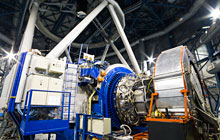KMOS
K-band Multi Object Spectrograph
Until the 1920s, astronomers believed that the Milky Way contained all of the stars in the Universe. With evidence from more powerful telescopes and after a big debate, they realised that the Milky Way was simply one of many galaxies in the Universe — in fact, just one of more than hundreds of billions… How difficult and long the journey has been trying to understand these objects! We have less than 100 years of studies behind us, and lots more to discover.
For that reason, astronomers are focussed on studying the beginning and evolution of these crucial structures in the Universe, and the K-band Multi Object Spectrograph (KMOS), installed on Unit Telescope 1 of the VLT, is specially designed for this task: to understand how galaxies grew and evolved in the early cosmos.
To study the early lives of galaxies, astronomers need to do three things: to observe in the infrared, to observe many objects at once and, for each one, to map out how their properties vary across the object. KMOS can do each of these things — and all at the same time.
How? KMOS is like an octopus, but with 24 deployable arms. Each arm is equipped with an Integral Field Unit (IFU) on the tip. “Each IFU can be positioned towards one distant galaxy, and then we can obtain spectra for up to 24 galaxies quite fast, meaning we make efficient use of telescope time,” says Dimitri Gadotti, Instrument Scientist behind KMOS. In the past, a large survey of galaxies could take many years. But now, with KMOS mapping and obtaining the properties of many objects simultaneously, it only takes a matter of months.
KMOS obtains spectra in the near-infrared part of the electromagnetic spectrum, which means that the light is decomposed into separate colours (like a rainbow) to obtain information: motions, ages, chemical content and more. The IFUs observe an area of sky big enough to cover the main area of distant galaxies, delivering spectra from the major structural components of these galaxies.
Why in near-infrared? Due to the expansion of the Universe, the light shifts to longer wavelengths, so the light from distant galaxies is shifted from visible-light wavelengths to the longer redder and infrared wavelengths. So the spectra, which contain much of the physical information, are collected by a very sensitive near-infrared detector.
One other amazing fact about of the arms of KMOS is that they are kept in very low temperatures: around -150 degrees Celsius! This is because if the arms are at room temperature, they emit so much infrared light that they significantly affect the spectra from objects in the sky. “It is an incredible engineering challenge to make these arms move, with the precision that they have to move, at such extreme temperatures,” says Dimitri.
KMOS is a second-generation instrument, and so there is a lot of work going on right now using the large amount of data that has already been collected. “One of the important steps in this initial phase is to try and understand the quality and characteristics of these data. We already see that KMOS allows us to study the dynamics of distant galaxies with an unprecedented efficiency,” Dimitri concludes.
Science highlights
- Distant galaxies dominated by normal matter (eso1709)
- 24-armed Giant to Probe Early Lives of Galaxies (eso1251)
|
On the tip of each of the 24 arms, a small optical device splits the image into 14 slices of 14 pixels each. These slices are aligned at the entrance of one of the three spectrographs, each of which disperses the light in wavelength, forming spectra of each of the original pixels, as seen on this raw image from one of the three detectors in KMOS. A software pipeline processes these images, and reorganises all the spectra in such way that the astronomer can analyse the full spectra of the 24 independent objects on which the arms were positioned. |
KMOSThe authoritative technical specifications as offered for astronomical observations are available from the Science Operation page.
|


